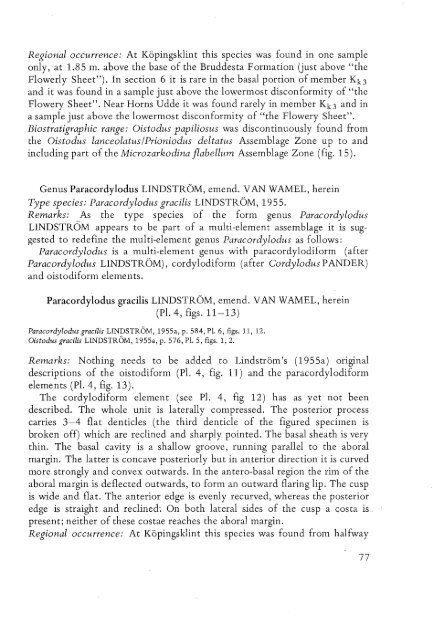UTRECHT MICROPALEONTOLOGICAL BUllETINS
UTRECHT MICROPALEONTOLOGICAL BUllETINS
UTRECHT MICROPALEONTOLOGICAL BUllETINS
You also want an ePaper? Increase the reach of your titles
YUMPU automatically turns print PDFs into web optimized ePapers that Google loves.
Regional occurrence: At Kopingsklint this species was found in one sample<br />
only, at 1.85 m. above the base of the Bruddesta Formation (just above "the<br />
Flowerly Sheet"). In section 6 it is rare in the basal portion of member Kk3<br />
and it was found in a sample just above the lowermost disconformity of "the<br />
Flowery Sheet". Near Horns Udde it was found rarely in member Kk3 and in<br />
a sample just above the lowermost disconformity of "the Flowery Sheet".<br />
Biostratigraphic range: Oistodus papiliosus was discontinuously found from<br />
the Oistodus lanceolatus/Prioniodus deltatus Assemblage Zone up to and<br />
including part of the Microzarkodina flabellum Assemblage Zone (fig. 15).<br />
Genus Paracordylodus LINDSTROM, emend. VAN WAMEL, herein<br />
Type species: Paracordylodus gracilis LINDSTROM, 1955.<br />
Remarks: As the type species of the form genus Paracordylodus<br />
LINDSTROM appears to be part of a multi-element assemblage it is suggested<br />
to redefine the multi-element genus Paracordylodus as follows:<br />
Paracordylodus is a multi-element genus with paracordylodiform (after<br />
Paracordylodus LINDSTROM), cordylodiform (after Cordylodus PANDER)<br />
and oistodiform elements.<br />
Paracordylodus<br />
gracilis LINDSTROM, emend. VAN WAMEL, herein<br />
(PI. 4, figs. 11-13)<br />
Paracordylodus gracilis LINDSTROM, 1955a, p. 584, PI. 6, figs. 11, 12.<br />
Oistodus gracilis LINDSTROM, 1955a, p. 576, PI. 5, figs. 1,2.<br />
Remarks: Nothing needs to be added to Lindstrom's (1955a) original<br />
descriptions of the oistodiform (PI. 4, fig. 11) and the paracordylodiform<br />
elements (PI. 4, fig. 13).<br />
The cordylodiform element (see PI. 4, fig 12) has as yet not been<br />
described. The whole unit is laterally compressed. The posterior process<br />
carries 3-4 flat denticles (the third denticle of the figured specimen is<br />
broken off) which are reclined and sharply pointed. The basal sheath is very<br />
thin. The basal cavity is a shallow groove, running parallel to the aboral<br />
margin. The latter is concave posteriorly but in anterior direction it is curved<br />
more strongly and convex outwards. In the antero-basal region the rim of the<br />
aboral margin is deflected outwards, to form an outward flaring lip. The cusp<br />
is wide and flat. The anterior edge is evenly recurved, whereas the posterior<br />
edge is straight and reclined: On both lateral sides of the cusp a costa is.<br />
present; neither of these costae reaches the aboral margin.<br />
Regional occurrence: At Kopingsklint this species was found from halfway
















